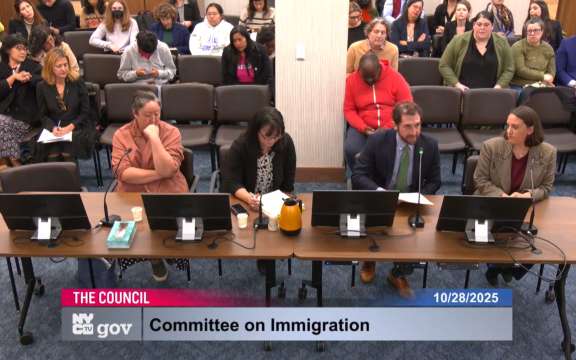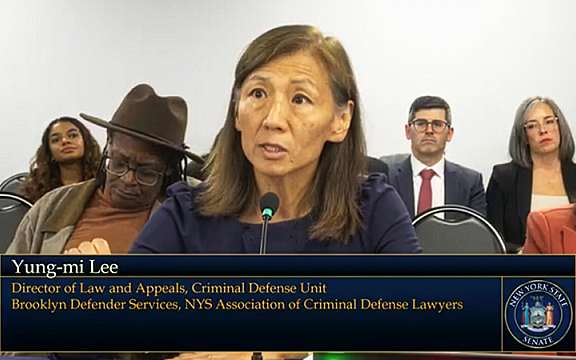NYC Public Defenders, Community Groups Unveil Ten-Point Plan to Address Growing Crisis of Deaths in NYPD Custody
September 22, 2025
Contact:
Redmond Haskins, The Legal Aid Society, rhaskins@legal-aid.org
Lupe Todd-Media, New York County Defender Services, ltoddmedina@nycds.org
Dan Ball, Brooklyn Defender Services, dball@bds.org
Anthony Chiarito, The Bronx Defenders, AChiarito@bronxdefenders.org
Piyali Basak, Neighborhood Defender Service of Harlem, pbasak@ndsny.org
***FOR IMMEDIATE RELEASE***
NYC Public Defenders, Community Groups Unveil Ten-Point Plan to Address Growing Crisis of Deaths in NYPD Custody
(NEW YORK, NY) - The Legal Aid Society, Brooklyn Defender Services, The Bronx Defenders, New York County Defender Services, the Neighborhood Defender Service of Harlem, elected officials, local community groups, and impacted New Yorkers rallied today on the steps of City Hall to announce a ten-point plan to address the recent deaths in New York City Police Department (NYPD) custody.
Today’s announcement comes in response to the recent deaths of Christopher Nieves, 46, who died in August at the Kings County courthouse despite showing signs of illness and repeated attempts by his defense counsel to secure him urgent medical care, and Musa Cetin, 29, who also died in August after being found unconscious in a holding cell at the Midtown South Precinct station house. The City’s medical examiner later determined that Mr. Cetin’s death was a suicide.
In July, 18-year-old Saniyah Cheatham died while in NYPD custody at the 41st Precinct in the Bronx. Police told her mother that Saniyah had taken her own life in a holding cell, but the family has publicly questioned that account and demanded the release of surveillance footage.
On March 26, a 43-year-old man died while awaiting arraignment at Manhattan Criminal Court. Reports indicate he had been arrested roughly 14 hours earlier and was being held in a courthouse holding cell at the time of his death. His identity was not released, and the cause of death remains unclear.
Days earlier, on March 21, Soso Ramishvili, 32, died in police custody at Brooklyn Criminal Court while awaiting arraignment. He languished in pain for three days and was deprived of medical care despite repeated pleas from defense lawyers and other personnel to secure him the treatment he needed.
At least nine people have lost their lives in NYPD custody this year alone, according to the Department.
“The thought of Christopher suffering while waiting to receive medical treatment for hours in a jail cell, before he passed away, breaks my heart,” said Candice Nieves, sister of Christopher Nieves, who passed away in NYPD custody last month. “No matter the misconceptions about my brother, his life mattered and he didn’t deserve to die! The system failed him! He was my baby brother and I loved him dearly. I wish I could have been there to wrap my arms around him during his last moments, so he could have felt he was loved and cared for. Instead he died on the cold hard jail cell floor, ignored and alone.”
“These deaths are not accidents — they are the direct result of systemic neglect, failed policing practices, and the City’s apathy to care for people in its custody.” said Tina Luongo, Chief Attorney of the Criminal Defense Practice at The Legal Aid Society. “The people and communities we serve have long raised concerns about the dangerous conditions inside NYPD custody, yet the City has failed to respond. Each death is a preventable tragedy, and we urge immediate action on this ten-point plan to help ensure that no more lives are lost.”
“It’s no coincidence that this disturbing rash of NYPD-related deaths coincides with the city’s revival of the widely discredited ‘quality of life’ policing initiative. ‘Broken windows’ policing has been a profound and shameful failure. Not only is it wildly ineffective at promoting community safety or addressing root causes of crime, it leads to more dangerous police encounters, needless incarceration, and in too many cases, completely preventable deaths,” said Stan Germán, Executive Director of the New York County Defender Services.
“At least nine people have already died this year while in NYPD custody. These are preventable tragedies, and every day without action risks more lives. Those responsible must be held accountable. The City must act now and launch full, independent investigations, guarantee access to immediate medical care in every precinct and every courthouse, and end the “broken windows” policing that targets people who are experiencing poverty, are unhoused, or are in need of mental health support. Lives are at stake today. One death in custody is already too many,” said Piyali Basak, Managing Director, Neighborhood Defender Service of Harlem.
“This summer, our Bronx community lost 18-year-old Saniyah Cheatham while she was in NYPD custody. Saniyah was just beginning her life, and her death should haunt every New Yorker. Families like Saniyah’s deserve answers, and automatic review by the CCRB is the very least we owe them. But justice for Saniyah must include justice for all New Yorkers who die in NYPD custody. This ten-point plan is a start, and we urge the City Council to consider it seriously and act swiftly to stop these preventable deaths,” said Juval O. Scott, Executive Director of The Bronx Defenders.
“There is a crisis of deaths in police custody in New York City. As public defenders, we cannot stand by as NYPD’s harmful policies, inaction, and callousness continue to claim the lives of New Yorkers,” said Lisa Schreibersdorf, Executive Director of Brooklyn Defenders. “NYPD’s pervasive policing of poverty and the illegal use of custodial arrests puts people in need of care into a system where their medical and mental health needs are far too often unaddressed leading to avoidable tragedies. We come together today to urge the New York Police Department, prosecutors, elected officials, and other stakeholders to take meaningful and immediate action on this ten-point plan so no more lives are lost.”
Darren Mack, Co-Director of Freedom Agenda, said “While New Yorkers have demanded real solutions for community safety and public health, Mayor Adams and Commissioner Tisch have turned to the failed playbook of broken-windows policing, and these tragic deaths in NYPD custody are the shameful and predictable result. Criminalizing poverty, addiction, and mental illness might play well with the billionaires Adams and Tisch want to appeal to, but it doesn't serve New Yorkers.”
“Our members, legal service workers and attorneys representing vulnerable and working class New Yorkers, have been sounding the alarm about the life-threatening conditions in NYPD custody for years. Every New Yorker’s life is precious and yet, because those in custody are often poor or working class or Black or Brown, the NYPD feels entitled to disregard their health and safety with impunity,” said Lisa Ohta, President of the Association of Legal Advocates and Attorneys, UAW Local 2325. “This status quo and lack of accountability is unacceptable to us, our members, and to our clients. The time for the Mayor and the Council to stop these senseless deaths is now.”
Council Member Tiffany Caban said, “The fact that 9 people have died in police custody this year is a horrific indictment of our whole criminal legal system. These deaths aren’t an accident or an aberration. They are systemic failures that should outrage every New Yorker. No one should die waiting for medical care in a jail cell. The ten-point plan put forward by public defenders and advocates is urgent and deeply needed, and the Council must respond with action. We cannot allow another name to be added to this list.”
DEMANDS TO ADDRESS CRISIS OF IN-CUSTODY NYPD DEATHS
1. Recognize the crisis of in-custody deaths and end broken windows policing
The plan calls for ending “quality of life/broken windows” policing, which the NYPD has expanded through “Q-Teams.” This approach targets poverty and untreated behavioral health needs, undermining both safety and public health. Instead, the City must eliminate waitlists and backlogs for mental health, substance use, housing, and food support services. The budget should continue investing in the “Crisis to Care” platform advanced by the Progressive Caucus. The City Council should use its oversight power to question Commissioner Tisch on the escalation of low-level arrests, which have led to unnecessary New Yorker deaths in the past six months.
2. Demand NYPD cease the illegal in-custody arrests of low-level offenses
The City Council must question the NYPD’s overuse of custodial arrests instead of issuing appearance tickets, as required by law. In 2025 alone, at least nine New Yorkers have died in NYPD custody — three while awaiting arraignment on low-level charges. The NYPD routinely violates CPL §150.20, which mandates appearance tickets for most minor offenses. These unlawful arrests are increasing, pushing people with medical and mental health needs into jails unequipped to provide proper care.
3. Request City Council inspections of NYPD central booking
City Council members must use their oversight powers to visit NYPD central booking locations to experience, first hand, the squalid and unsafe conditions that New Yorkers are detained in 24 hours a day and the lack of coordination between medical staff in central booking and requests for medical attention.
4. Create independent EMS staffing in courthouses
The City should station independent EMS workers — not under NYPD authority — in every arraignment courtroom and courthouse during all open hours (9am–1am), with emergency personnel also available for people brought from Rikers.
This would supplement the 24/7 Enhanced Pre-Arraignment Screening Unit (EPASU) staff in central booking, whose screenings depend on the NYPD bringing people to them and have not prevented deaths in custody. EMS must be readily available in central booking and arraignments, and the City Council should expand EPASU duties to include evaluating all people in custody and responding to medical needs — whether self-reported, attorney-requested, or officer-observed.
5. Engage in oversight on suicide prevention and mental health standards
Serious inquiry is needed into the NYPD’s failure to implement measures to prevent suicides in its precincts. This should include whether officers are trained in, and consistently applying, mental health minimum standards. The review must also examine whether existing patrol guide standards for people in custody who require immediate medical or psychiatric care are being ignored — or are simply inadequate to prevent crises from escalating into death.
6. Empower automatic CCRB investigations of in-custody deaths
The City Council should require the Civilian Complaint Review Board (CCRB) to automatically initiate independent investigations into every NYPD in-custody death. CCRB must be granted direct access to NYPD records and databases, alongside the Force Investigation Division (FID), to ensure timely and effective investigations. The City Council should also guarantee that CCRB is adequately staffed and resourced to meet this mandate.
FID investigations lack transparency and, in public defenders’ experience, are neither thorough nor timely. For example, in the case of Allan Feliz, FID kept its investigation open for more than two years, delaying CCRB’s review past the 18-month deadline for most disciplinary charges. FID should not be the primary investigative body for the public or for families of people who die in custody.
7. Demand DOI-OIG systemic investigation
The plan calls on the City Council to issue a formal “must-investigate” directive to the Office of the Inspector General for the NYPD (DOI-OIG), requiring an investigation into fatal deficiencies in NYPD policies, practices, and procedures, including FID investigations of in-custody deaths. DOI-OIG should publish its findings and recommendations to prevent future deaths.
This inquiry must also address NYPD’s failure to implement suicide-prevention measures in its precincts and assess whether officers are trained on, and following, minimum mental health standards. For example, patrol guide provision PG 210-04 requires immediate medical or psychiatric care for people in custody — standards that may not be applied.
The City Council must ensure DOI-OIG is adequately staffed and resourced to fulfill its mandate as an independent oversight body of NYPD patterns and practices.
8. Amend the NYPD Disciplinary Matrix
The NYPD must amend its Disciplinary Matrix to eliminate the separate category of “negligent failure to provide medical assistance.” Any failure to provide medical care to someone in custody — who is entirely under NYPD control — should be treated as serious misconduct, with severe presumptive penalties, including termination. Negligence can already be considered a mitigating factor within the Matrix; creating a separate category only weakens accountability. Just as NYPD action that causes death can trigger suspension and discipline, inaction that results in death must also lead to immediate suspension and full disciplinary proceedings.
9. Demand Changes from Prosecutors
The plan calls on all criminal legal system actors to take immediate steps to address their role in the crisis of in-custody deaths. Prosecutors’ disparate handling of violation and misdemeanor complaints, coupled with an excessive reliance on pre-arraignment detention instead of issuing appearance tickets as required by CPL 150.20, must be examined by the City Council. These practices contribute directly to the deadly conditions of pre-arraignment incarceration.
The policy of denying appearance tickets in petit larceny cases solely because of a potential order of protection should also be reformed. Prosecutors, working with the courts, should establish amnesty days to allow people to clear old bench warrants without fear, and should dismiss outstanding warrants.
10. Support emergency stop-gap medical request process
As an emergency stop-gap measure to address the City’s failure to care for people in its custody, NYC defenders will implement a formal written request form for medical attention, to be completed alongside any oral request to NYPD for emergency assistance. The defense attorney will sign the form and record the date and time of the request, the name and badge number of the officer receiving it, and the officer overseeing the holding area. Copies will be provided to the NYPD sergeant on duty, who must record receipt in the digital duty logs.
NYPD should then immediately investigate and report on the condition of the person in custody and determine what action will be taken. As required by the Patrol Guide, NYPD must also maintain records of these determinations and actions. This stop-gap measure does not replace the City’s obligation to provide adequate care for those it detains.
Read the full ten-point plan here.
###
Find PDF of press release here.



